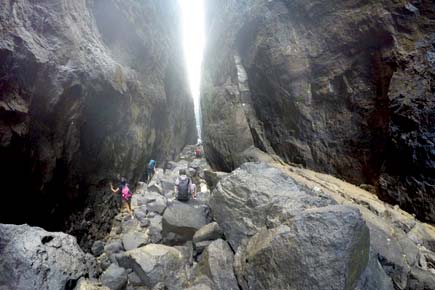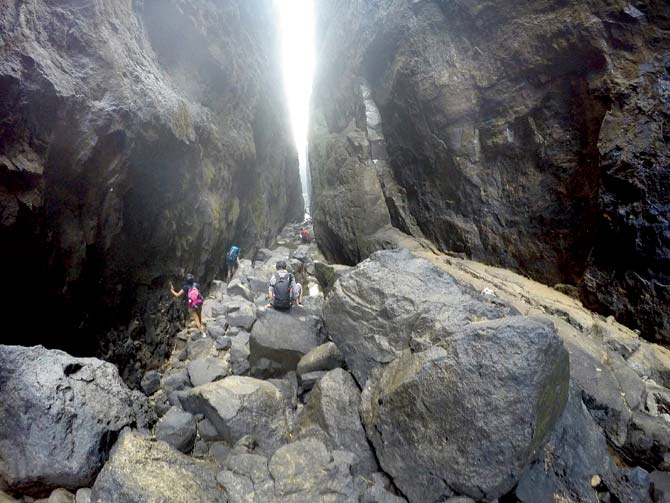The Western Ghats offer Mumbai's keen trekkers the perfect weekend getaway, especially in this weather. But it's an industry where no government regulations apply and your guide probably doesn’t have training in handling a crowd or first-aid

Last month, on a rainy Saturday, a hiking party from Mumbai came face to face with its worst nightmare while traversing a dewy stretch up a Matheran hill. The hikers were at Peb fort in Karjat taluka, when one youth — Harshad Bhole (19) — was hit by a pile of falling rocks. While Harshad was seriously injured in the incident, what made things worse was the delayed response time in treating him. His brother, Pranay, also part of the group, later said that locals helped rush Harshad downhill. But, by the time he was taken to the government hospital in Neral, two hours had already passed and he had lost blood. The 19-year-old died soon after.

Sandhan Valley is a 200 feet-deep canyon located near the Bhandardara region in the Sahyadris. Trekking the valley during the monsoons can be fatal due to falling rocks and the many, deep pools of water inside. At present, except for locals, there is no one on site to warn reckless trekkers. Pic/Dylan D' Silva
ADVERTISEMENT
It’s hard to pinpoint what exactly may have gone wrong. One could blame the waywardness of nature or the unavailability of immediate rescue facilities. “But, some precaution on part of the trekkers could have saved a life,” says Dhiren Talpade, founder-director of Jumpstart Outdoors Ltd, an adventure tour platform that operates out of Mumbai.

Dhiren Talpade of Jumpstart Outdoors Ltd. attended a first-aid workshop by NOLS, India, in 2008. He later followed it up with a Wilderness First Responder course, and now, gets himself recertified with NOLS every two years
Every weekend, despite several cautionary warnings, similar tragedies unfold in the Sahyadris. Recently, the body of a 28-year-old trekker was found on top of Barad Hills in Talasari. Another software engineer from Pune died after a boulder fell on his back at Raigad fort.
With over 100 hiking groups crawling the mountains every weekend across Maharashtra, the need of the hour is to ensure that accidents are kept in check. However, with little or no regulation in place, these efforts become twice as challenging.
The buck stops with you
Hiking, or any adventure sport, has caught the fancy of Indians only recently, says globe-trotter and avid trekker 33-year-old Vahishta Mistry, who quit his full-time job in 2013, to travel the world. “Since we are not a hiking culture, government bodies here have done little to incentivise the sport,” says Mistry, adding, “This means that you have to do everything by yourself.”
From marking trails to getting the right trekking gear and ensuring safety measures are adhered to — everything falls under the ambit and responsibility of a trekker.
“In Maharashtra, it’s more or less a community-driven sport,” says 34-year-old Vikrant Chheda, founder of White Collar Hippie, a travel company that offers off-beat outdoor experiences.
“The trails are marked as easy, moderate or difficult, based on experience gathered over the years by adventure companies, clubs or associations,” adds Chheda.
But, while the logistics of trekking are usually taken care of, most adventure groups fall short in ensuring safety measures are in place. “Trekking is a dangerous activity. In the last four years, there have been a considerable number of deaths, and at least some of these could have been avoided,” says Talpade. “People do not consider safety an important aspect of trekking. They would rather break a limb or die, than be prepared,” he adds.
Talpade partially blames it on the mushrooming of adventure operators in the market. “In 2011, the travel industry saw a sudden boom. Every second person was starting a new adventure outfit. Many were those who’d go on treks with somebody, and, before you knew it, they were leading treks themselves,” says Talpade. “While this is all right from the point of view of enterprise, 80 per cent of the groups handling outdoor adventure sports in Maharashtra today, have little clue of how to cope with accidents that take place in the outdoors.”
Talpade himself claims to have been ill-equipped to handle crisis-like situations, until he attended a four-day first-aid workshop by National Outdoor Leadership School (NOLS), India, in 2008. He later followed it up with a Wilderness First Responder (WFR) training course, and now, gets himself recertified with NOLS every two years. He also conducts free first-aid workshops for adventure enthusiasts in the city.
According to Chheda, one measure to avoid mishaps is to ensure that there are enough guides to handle the trekking group. “The ratio of the number of guides to that of the clients should always be maintained. We usually follow a 1:8 or 2:10 ratio, depending on the type of group (young or old) we are handling. We also take the phone numbers of doctors and local ambulances in the vicinity, and keep them in the loop about us being around, in case of emergency,” says Chheda.
Outward Bound India - Himalaya, the Indian arm of Outward Bound International — a worldwide outdoor learning organisation — follows a standardised protocol to assess and manage risk in the arena of adventure, outdoor and wilderness activities. “The basic methodology to ensure safety, lies in risk assessment and management. Once you know what could be a risk, you can cater for checks, balances or avoidance thereby creating a safety net. That’s the basic you can do, for safety in the field, and this is what’s essentially practised worldwide. We also do something, which is rather bureaucratic. Post the programme, we get feedback from facilitators, instructors and the incident management team. Here, we review if any incident occurred and if it did, how did we react to it. This helps mitigate future incidents,” says Pavane Mann, executive director of Delhi-based Outward Bound India - Himalaya.
Sherwin Rebello, founder of The Land of Wanderlust that undertakes budgeted trips outside Maharashtra, suggests hiking with a minimum of four persons, including a local, irrespective of how easy the terrain is. “Never do it alone,” he says.
Everyone’s a company
If you thought starting an adventure company was as tedious as baking your own bread, you are in for a surprise. “All you need is to register under the Maharashtra Shop and Establishment Act and form a partnership or an ownership firm, so that you have a document for a current bank account,” says Talpade. Rebello says he followed a similar protocol when establishing his company in 2012.
The scenario is very different in the West. To you start your own company in Europe and America, you require multiple certifications from registered bodies. You also need to complete a 90-hour WFR course with NOLS, says Talpade.
According to Mistry, who has spent nine months trekking in the US, one of the things that differentiates the US and India, when it comes to the sport, is that there’s a huge hiking culture there, due to which there is public pressure on the government to maintain and have infrastructure. “Part of the mandate is to make sure that people have a safe time in national, local or county parks. It entails accurately marking trails and making sure that at every trail head, there is a bunch of maps and resources, including forest rangers and immediate recourse to emergency services. If owing to a natural calamity (like landslides), the landscape changes, a new trail is marked out within weeks. When you have such infrastructure, one doesn’t need an organisation to lead a trekking group,” says Mistry.
An unregulated sport
Currently, adventure sports are not regulated by the government, largely because the industry is still nascent in Maharashtra, says Talpade. But, the arbitrary ways of several adventure start-ups and tour operators with a devil-may-care attitude towards safety procedures, has put the industry on tenterhooks, a time too many.
This is why Adventure Tour Operators of Maharashtra (ATOM) — created on the lines of Adventure Tour Operators Association of India — was formed five years ago. “The idea behind ATOM was to get both commercial operators and clubs from within Maharashtra involved in a standardised practice, without the government having to enforce anything on us. So, we introduced uniform safety measures, operating procedures and a point of recourse for people, who haven’t had a good experience with tour groups,” says Andre Morris, president of ATOM, and founder of tour company Outbound Adventure. One can register with ATOM for an annual fee, and has to adhere to the rules stipulated by the association. Another plan of ATOM was to document the net worth of this growing sport. Industry experts claim that with an average day-long hike priced anywhere between Rs 600 to Rs 1,000 per head, the profits could run into crores annually.
In June 2014, when a Government Resolution, atte-mpted to thwart the free reign of tour operators in Maharashtra, ATOM was among the first to raise an objection. “It did ruffle a lot of feathers,” says Talpade.
Following a PIL filed by the association, the High Court put the GR on hold; the case is now subjudice. “While I am not against the idea of regulating the sport, our grouse with the GR was the ridiculous clauses,” says 54-year-old Morris, who has been part of the trekking industry for over 30 years. “The GR states that one needs to take permission from the district collector or the seniormost police officer in the area, before heading out in a group, without specifying what entails a group. The babus are going to look at this as an opportunity to make money,” he adds.
Another aspect is the certification. The GR states that tour operators would need a basic or advance certificate from a government body. At present, Morris says that there are only five Himalayan mountaineering schools recognised by the government. “But, these schools only focus on teaching you how to summit peaks in the Himalayas. How will such a certification prepare you to handle a group in the Sahyadris, which has a very different landscape?” Morris asks. “The Himalayas have ice and snow, and while that is phenomenal, the Sahyadris, which are all volcanic, offer a whole bio-system of rich plant and animal life. Also, rock climbing in the Sahyadris is a lot tougher than in the Himalayas, because while you have all kinds of gear like pitons and crampons to use there, in the Western Ghats you don’t have any equipment that you can use to dig into the rock,” says Morris.
He instead suggests that the government focus on creating schools or establishments in the state, to address this gap. “If they do plan to introduce a regulation, they should try and involve more people from within the industry,” he says.
Regulation, however, is still a grey area for most tour operators. The sport rests on thrills, and regulating it will only act as kill joy and take away from enjoying the experience, feels Rebello.
Mann of OBI, who has more than 30 years of experience in the field and helped compile the Wilderness code for Uttarakhand, says that the occurrences of accidents and disasters are unfortunate. “As more people become aware of what’s required in an adventure or wilderness programme, in terms of safety, they will start asking the right questions and get pickier about the company, guide or trip leader they choose. At the time, the providers will naturally have to match up to the right standards. It is a cart and horse story.”
 Subscribe today by clicking the link and stay updated with the latest news!" Click here!
Subscribe today by clicking the link and stay updated with the latest news!" Click here!







